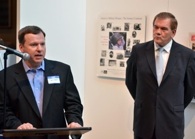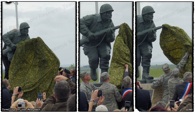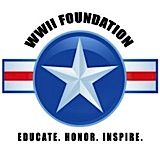WWII Foundation – Interview with Chairman Tim Gray
 Tim Gray is chairman of the WWII Foundation, a group that is working to preserve the memories of World War II veterans. Its logo urges, "Educate. Honor. Inspire." Its board members include Ken Rendell, Director of the Museum of World War II; Lt. Col. (ret) James Megellas, the most decorated officer in the history of the 82nd Airborne Division; retired Marine captain Dale Dye, whose company works with filmmakers and actors to help them depict military operations with greater accuracy; former Pennsylvania governor and director of Homeland Security Tom Ridge; and a number of other well-known actors, athletes, historians, etc.
Tim Gray is chairman of the WWII Foundation, a group that is working to preserve the memories of World War II veterans. Its logo urges, "Educate. Honor. Inspire." Its board members include Ken Rendell, Director of the Museum of World War II; Lt. Col. (ret) James Megellas, the most decorated officer in the history of the 82nd Airborne Division; retired Marine captain Dale Dye, whose company works with filmmakers and actors to help them depict military operations with greater accuracy; former Pennsylvania governor and director of Homeland Security Tom Ridge; and a number of other well-known actors, athletes, historians, etc.
Tim left a successful career in broadcasting to found a company that produces corporate media but that also produces World War II–themed documentaries. The first two such documentaries from the Rhode Island–based company received New England Emmy awards for writing and production. The Foundation and Gray have been featured in news stories on CBS This Morning, American History TV on CSPAN3, and Fox News, as well as print publications that include The Boston Globe, Philadelphia Inquirer, and Weider History Group’s own World War II magazine.
{default}In this exclusive interview, Armchair General put seven questions to Tim about the WWII Foundation and his documentary work.
Armchair General: First of all, tell us about the WWII Foundation. Its motto is "Educate. Honor. Inspire." When was it formed, and what is its focus?
Tim Gray: The Foundation was formed under the umbrella of Tim Gray Media in 2006 with our first World War II documentary film, D-Day: The Price of Freedom. We became an official 501 c3 in the spring of 2011. Since 2006 we have produced four films, with a 5th currently in post-production and a sixth just recently written and waiting to be edited. We have three more films in the works for the rest of 2012 and into 2013, including a project on a Holocaust survivor we recently took back to Poland and Germany. The goal is to donate all our films upon their completion to American Public Television (PBS) so people across the country can hear the stories of these amazing men, women and survivors of World War II. We also donate all of our films to schools and libraries across the country.
ACG: The Foundation initiated the Richard Winters Leadership Project. What is the focus of that project?
TG: Phase one of the project was the creation of a monument, a statue featuring the likeness of Major Richard "Dick" Winters, to honor leadership on D-Day. Phase two is an upcoming documentary on leadership of men in combat, focusing on the 10 principles of success developed by Dick Winters during his time in battle and how those characteristics of leadership translate to civilian life as well. The film will be narrated by Damian Lewis, who played Major Winters in Band of Brothers. The documentary will be donated to schools and libraries in Pennsylvania on behalf of the late major and his wife, Ethel. A leadership award will also be announced in Major Winters’ name at his alma mater, Franklin and Marshall College. The annual award will go to a student there who displays leadership qualities while in college.
 The Richard Winters Leadership Monument was dedicated in Normandy on June 6th, 2012. We were honored to have the event hosted by Governor Tom Ridge, former Secretary of Homeland Security of the United States, and Major General James McConville, commanding general of the 101st Airborne Association. We worked closely with the French in Normandy who had a special relationship with Major Winters after World War II. The 12-foot-high statue is located just outside of the village of Sainte-Marie-du-Mont, on the main road (the D913) to Utah Beach. He was the perfect choice for this leadership monument based on the location it is in.
The Richard Winters Leadership Monument was dedicated in Normandy on June 6th, 2012. We were honored to have the event hosted by Governor Tom Ridge, former Secretary of Homeland Security of the United States, and Major General James McConville, commanding general of the 101st Airborne Association. We worked closely with the French in Normandy who had a special relationship with Major Winters after World War II. The 12-foot-high statue is located just outside of the village of Sainte-Marie-du-Mont, on the main road (the D913) to Utah Beach. He was the perfect choice for this leadership monument based on the location it is in.
ACG: There are some people, including some on our ACG forums, who feel Richard "Dick" Winters is being exploited or that he and the "Band of Brothers" get too much attention. How would you respond to those opinions?
TG: We left it up to Major Winters prior to his passing in 2011 if he wanted the leadership monument to proceed, and he said yes. We also made is very clear that while the statue was a likeness of Richard D. Winters and utilized a quote from him about men who respond to the call from their nation to serve, the monument itself was focused on leadership on D-Day.
All the American Army divisions and corps that took part on June 6, 1944, are recognized prominently on the monument. That’s the only way Dick Winters would have given his ok to this, if everyone was recognized. He was a very humble man. Books, movies and television shows that share stories of men like Dick Winters, Audie Murphy, George Patton, Jim Gavin, John Basilone, Eugene Sledge, Robert Leckie and Pappy Boyington keep the World War II conversation moving forward. We all need heroes.
 Everyone who fought in World War II has his, or her, own individual story; many however are never shared and too many veterans pass away without leaving behind their own personal experience, many of which would make great films, books or TV programs. Dick Winters was a hero to many people, including 11-year-old Jordan Brown of Lebanon, Pennsylvania, who led a team that raised $100,000 for the monument. Jordan was something special. He enabled us to look at Major Winters through the eyes of a boy who just wanted to honor a 92-year-old man he admired and respected.
Everyone who fought in World War II has his, or her, own individual story; many however are never shared and too many veterans pass away without leaving behind their own personal experience, many of which would make great films, books or TV programs. Dick Winters was a hero to many people, including 11-year-old Jordan Brown of Lebanon, Pennsylvania, who led a team that raised $100,000 for the monument. Jordan was something special. He enabled us to look at Major Winters through the eyes of a boy who just wanted to honor a 92-year-old man he admired and respected.
I wish I had 100 Jordan Browns involved in all our projects. I encourage everyone to honor the men (and women) of World War II they feel are their heroes in life. I wish I could build monuments and produce films honoring them all. Twenty years from now when all these veterans are gone, many others will feel t
ACG: It’s been written elsewhere that you developed your interest in World War II when you picked up a World War II encyclopedia and couldn’t put it down. What was it that grabbed you about the topic and why has it remained so important to you all these years?
TG: It’s all the individual stories of those caught up in the drama of World War II. Everyone who fought or was involved, as a survivor or combatant, has his or her own individual story from that time, whether serving on the front lines or on the home front. Everyone experienced the war in a different way. Our films are focused on bringing these people back to the places where they experienced World War II—Europe, Pacific or the home front. It is amazing what can be recalled in these situations by a veteran or survivor when they revisit places like Normandy, Bastogne, Guadalcanal, Iwo Jima or Auschwitz-Birkenau or Treblinka.
ACG: You walked away from a successful career as a television sportscaster and reporter in order to make documentary films. What prompted you to make such a leap of faith?
 TG: I had more of a passion for preserving the stories of World War II then I ever had doing television. Not even close. Our films are airing across the country on PBS stations and we have won several Emmy Awards for our projects, but the greatest satisfaction comes from situations like standing with Jim Megellas of the 82nd Airborne Division at the Waal River as he recounts the carnage of the crossing there in September of 1944. Priceless.
TG: I had more of a passion for preserving the stories of World War II then I ever had doing television. Not even close. Our films are airing across the country on PBS stations and we have won several Emmy Awards for our projects, but the greatest satisfaction comes from situations like standing with Jim Megellas of the 82nd Airborne Division at the Waal River as he recounts the carnage of the crossing there in September of 1944. Priceless.
ACG: Documentaries don’t have the reach of big-budget movies or even some independent films. How can our readers view some of your work?
TG: They can check with their local PBS stations or visit our WWII Foundation Website to see some samples of the non-profit work we do. We are running out of time to interview this generation. The window is closing so fast that it makes me sad that some of the best and most inspirational stories from the war will pass on quietly as the veterans and survivors leave us.
 ACG: What lies down the road? What are some of your future projects, and what would you like to see the WWII Foundation doing 10 years from now?
ACG: What lies down the road? What are some of your future projects, and what would you like to see the WWII Foundation doing 10 years from now?
TG: We have to keep raising money to keep our mission moving forward. That’s the hardest part of what I do. Out of every 100 people I reach out to, maybe one or two really understands what we are trying to do. The goal in 10 years is to have as many of these films airing free across the country as possible. I just can’t tell you how important this is. When we say goodbye to our last living World War II veteran we will all look around and say, “Where did they all go?” I want to make sure we keep as many of their stories around as possible so that future generations have free access to learn what courage and sacrifice was about at that decisive time in world history.


I have two journals 1944 and 1945 that my Dad wrote in EVERY day he was in WWII. My Dad died in 1999 at the age of 82 years. We NEVER knew he had these two journals until my brother was looking through our Dad’s papers.
My brother KNEW I would want these and am I am curious if there is a place in your program that will benefit from his written words, day by day, as I have learned very much of his world, feelings, angst and joy.
Thank you.
My father was in WWII in the 82AirBorne and died when I was 12 so was too young to ask him about his war Tim experiences. I watch every movie but they are always about the 101 st. I know daddy served in every invasion His name was James Perry Best Jr. I would love to find someone who knew hem. I was hoping you might help me in I’m search. I would certainly appreciate it.
Edie Best